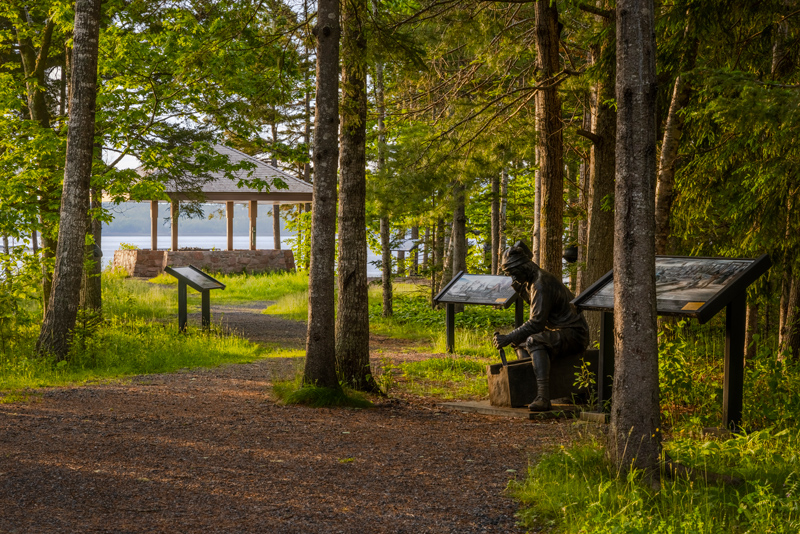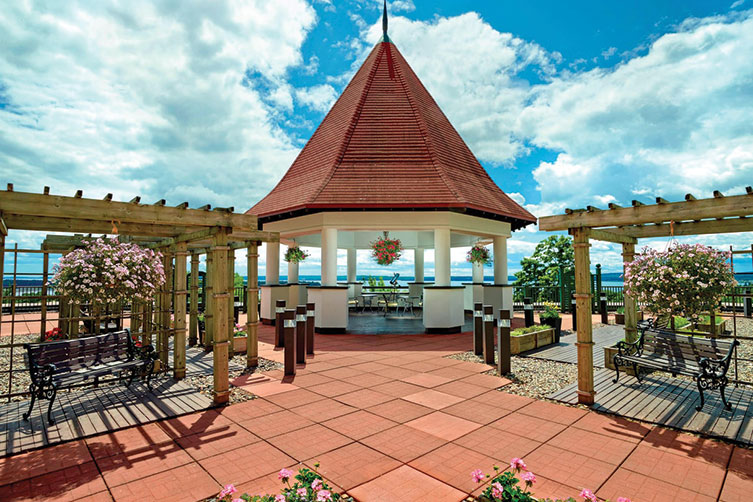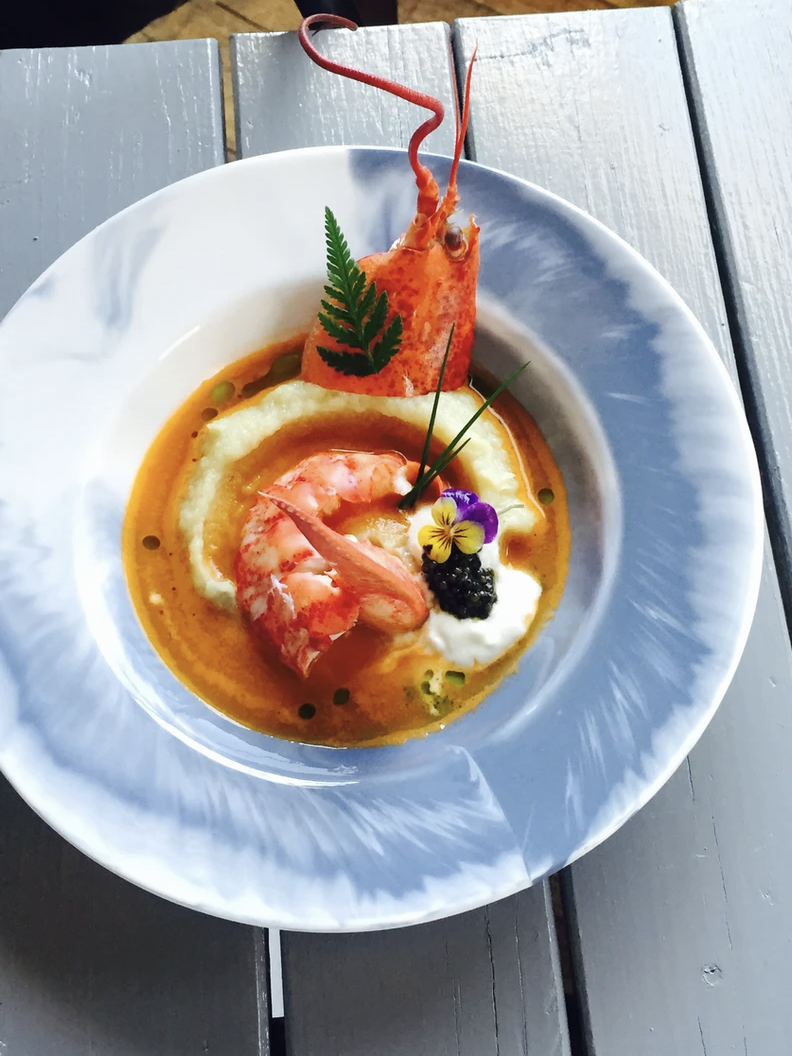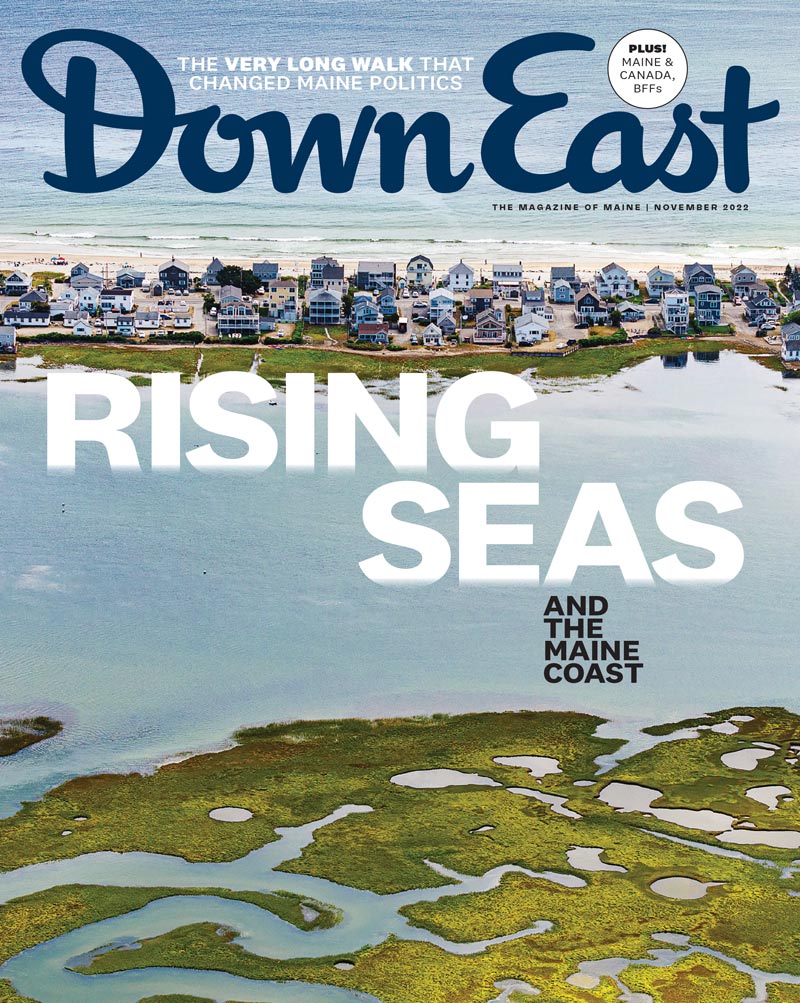By Mary Pols
From our November 2022 issue
The dress was purchased, the date set, the caterer paid. Then, Nova Scotia-based couple Lindsay Clowes and Alex Leckie had to call off their summer 2020 wedding. The U.S.–Canada border had shut down in the early days of the pandemic, and Clowes has family in Maine. They wanted to make sure everyone could make it, so they came up with an unusual nuptial plan: that October, they said their “I Dos” on a wharf in St. Stephen, New Brunswick, as guests lined both sides of the St. Croix River and a skiff full of relatives puttered in between. CNN and the CBC were among the many outlets to pick up the feel-good story. For our November 2022 feature on the nebulous Maine–Canada border, we asked the bride and others how the border-spanning, headline-making wedding came together.
Lindsay Leckie, bride: I think my catering had to be used within a year. So there was that. Also, I think I am just too impatient and anxious.
Leslie Reeve Bernardini, mother of the bride: Lindsay said, “Hey look, we want to do a border wedding. We don’t want to wait.”
Leckie: So many people have ties to both sides. I always describe St. Stephen and Calais as one town with a border in between. I crossed the border every day through grade 12.
Bernardini: I grew up in Fredericton, New Brunswick, and Lindsay was born there. We moved to Calais 22 years ago, when I married [Lindsay’s stepfather] Chris. Lindsay continued to go to school in St. Stephen, in a French-immersion program.
Leckie: We thought about doing the wedding in Robbinston, but the river is a lot wider there.
Bernardini: Chris and I would often go on a Sunday to sit and have coffee [at the floating wharf in Calais], and I looked across the river at St. Stephen. That was probably the closest point. So I called Allan.
Allan MacEachern, mayor of St. Stephen: Leslie is a long-time friend to my wife and I. The wharf is normally used by the public, but we privatized it for the wedding.
Nicole Reid, photographer: Leslie contacted me, as I was a new photographer and wasn’t booked on that date.


Bernardini: She said, “I only do family photos.” I said, “I don’t care. I’m so desperate. This is happening in under
six weeks!”
Leckie: At that point, I was like, “I am not going to care too much because I have seen what people look like when they are worried about everything.”
Bernardini: Chris and I had to quarantine for two weeks in Canada to go to the wedding.
Leckie: It was like everyone did a part. Some people decorated. My bridesmaid’s boyfriend did the video.
MacEachern: Small-town living allows an event like this to come together.
Bernardini: The weather was perfect. Sunny, with a bit of a breeze. The people in the boat — my mother- and father-in-law and other in-laws — circled around the wharf. And they could hear through the speakers.
Leckie: The speakers weren’t planned. My best friend since fourth grade, her dad owns the electronics store in town. He was like, casually, “Do you want me to bring speakers?” Then I show up and there is this huge sound system.
Bernardini: The word got out, so there were quite a few people on the waterfront. A reporter showed up from [New Brunswick’s] Telegraph Journal. This all went viral.
Leckie: It was a little nuts. There were some big news channels that I didn’t even respond to.
Bernardini: Why were people so interested? I think because it was just a really happy story in a time when people couldn’t cross [the border]. I left to go back to the U.S. with a permanent grin on my face. It was just that magical.

Two-Nation Vacation: Grab your passport for your own both-banks tour of the St. Croix Riviera.
PLAY
Start your sightseeing on the U.S. side, at Maine’s most overlooked National Park Service property. Saint Croix Island International Historic Site commemorates the French’s first attempt at a North American colony, in 1604, on an island in the river. A rough winter scared off the French, but today, there’s a fascinating interpretive trail on the mainland that tells the story of the settlers and the Passamaquoddy who helped them out — and on whose ancestral territory the French planted a flag. Worth a stop just to see the impressive outdoor bronze sculptures, illustrating the history, installed in 2003. No entrance fee. Visitor center open late May–mid-October. Trail open year-round.
For a longer, woodsier walk, stop at one of two little-visited preserves: A couple miles north from the Saint Croix site, Devil’s Head Conservation Area is a striking headland rising 340 feet above the waterline, with 21⁄2 miles of trails offering nice river views from the bluff (and likely osprey sightings). No fee. On the Canadian side — south of St. Stephen, a half-hour drive from Devil’s Head, if the customs line is short — Ganong Nature Park is the beach-ringed peninsula you viewed from across the river at Devil’s Head, with more than four miles of mostly wooded trails and nice beaches and tide pools at low tide. No fee. The Kingsbrae Garden is arguably the top attraction in the resort town of St. Andrews, a half-hour drive from the border at Calais. In season, the grand 27-acre garden shows off some 2,500 varieties of perennials and some impressive landscaping. $17, with discounts for families and seniors. Open late May–mid-October.

STAY
Mainers who think of Calais and surrounds as the hinterlands may be surprised at the gentility of St. Andrews. The turreted, Tudor-style Algonquin Resort is elegant and modern, with balconies overlooking the river, a renowned golf course, and a kilted bagpiper on the lawn each evening. Down the road, the Kingsbrae Arms is a luxe boutique inn built as a summer cottage for a Gilded Age shipping magnate. Think elaborate chandeliers and rich upholstery.

EAT
Outside St. Andrews, in quiet Chamook, the dining room at Rossmount Inn is a mainstay on lists of Canada’s best restaurants. Local seafood, organically grown veggies, and wild-harvested ingredients served in a white-tablecloth atmosphere. Mainers may appreciate chef-owner Chris Aerni’s signature lobster cocktail, made with pickled beet salad and celery remoulade. Reservations a must.






